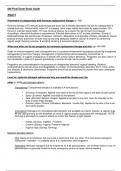Exam (elaborations)
Summary NR566 NR 566 Final Exam Study Guide (Latest ) Advanced Pharmacology for Care of family
- Course
- NR566
- Institution
- Chamberlain College Of Nursing
566 Final Exam Study Guide Week 5 Prevention of osteoporosis with hormone replacement therapy (p. 433) Hormone therapy (HT) reduces postmenopausal bone loss & thereby decreases the risk for osteoporosis & related fractures. Unfortunately, when HT is stopped, bone mass rapidly decreases by approxim...
[Show more]



